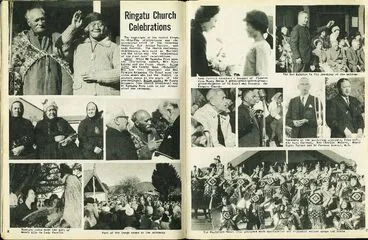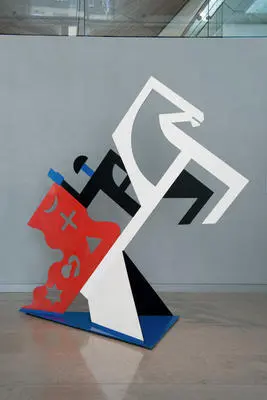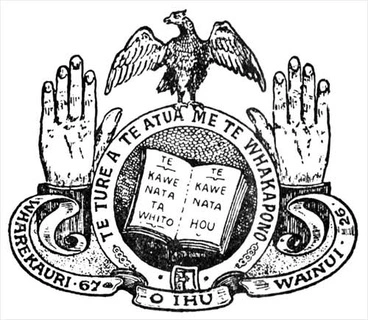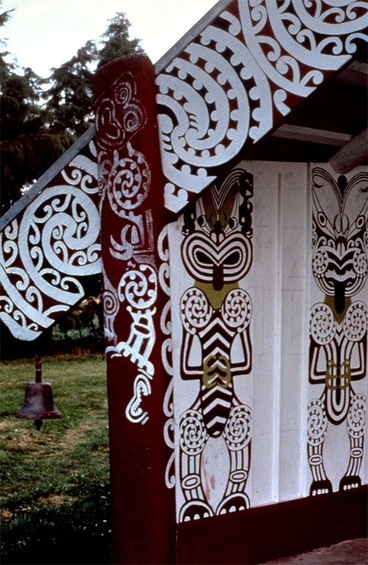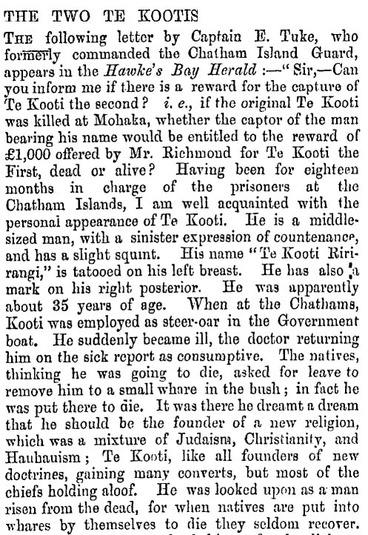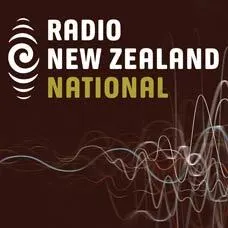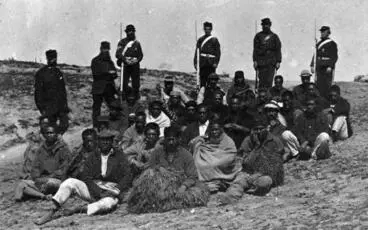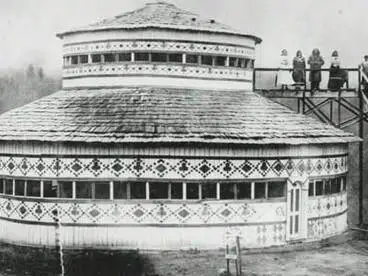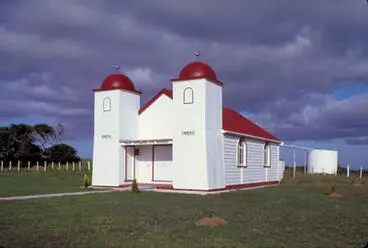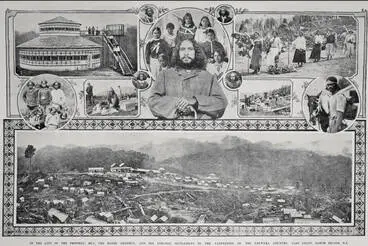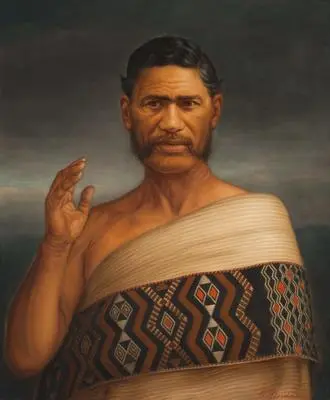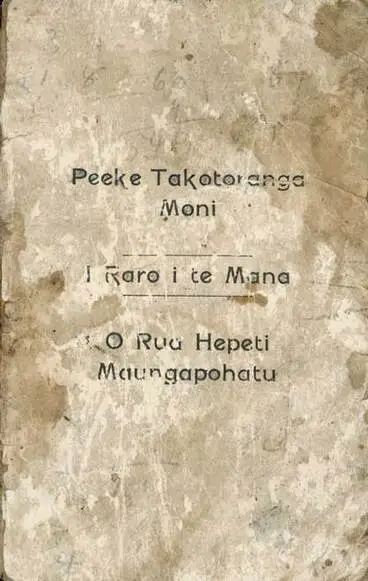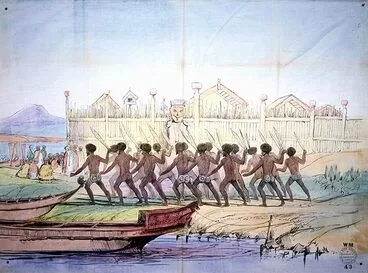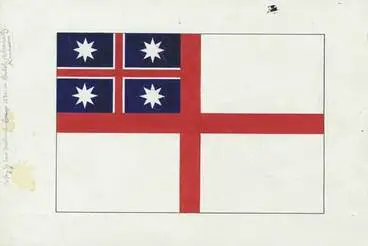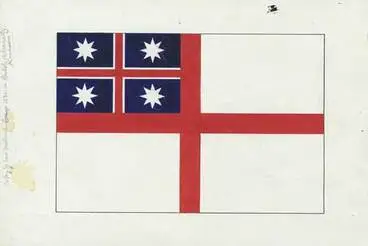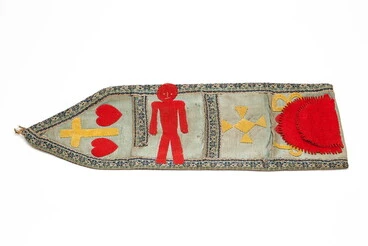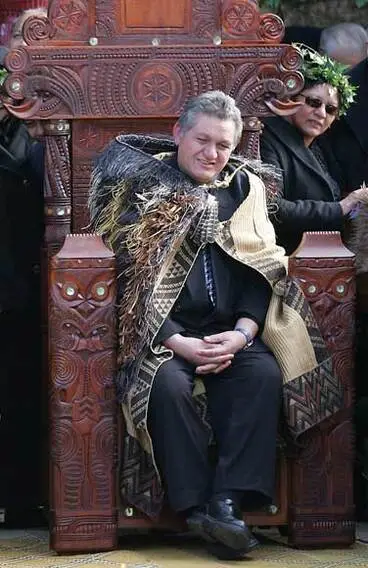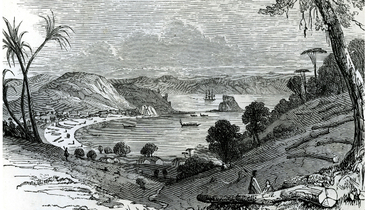Māori Religious Movements
A DigitalNZ Story by National Library of New Zealand Topics
Pre-European Māori recognised a hierarchy of gods and spiritual influences that connected the community with the environment. While colonialism led to many Māori converting to Christianity, it also gave rise to new Māori-centric religions like Ringatu, Pai Mārire and later Ratana. These were led by charismatic leaders including Te Ua Haumēne, Te Whiti, and Rua Kenana. SCIS no: 1895584
social_sciences, technology, arts, english, history, health, Māori
Ratana Pa - service in the temple
Alexander Turnbull Library
Tahupōtiki Rātana
Museum of New Zealand Te Papa Tongarewa
Rātana Church and Mita Ririnui: The colours of service
Services to Schools
Kiingitanga flags
Manatū Taonga, the Ministry for Culture and Heritage
Kiingitanga
Services to Schools
Māori King movement origins
Services to Schools
Ringatū flags: Te Wepu
Manatū Taonga, the Ministry for Culture and Heritage
Ringatu Church Celebrations
Gisborne Photo News
Ringatu/Te Wepu
Auckland Art Gallery Toi o Tāmaki
Ringatu flag captured from Te Kooti
Alexander Turnbull Library
The seal of the Ringatū Church
Manatū Taonga, the Ministry for Culture and Heritage
Te Kooti – Ringatū
Manatū Taonga, the Ministry for Culture and Heritage
A Ringatu Meeting At Ruatoki; Traditional Customs - (Te Ao Hou - No. 42 March 1963)
Alexander Turnbull Library
Rongopai
Manatū Taonga, the Ministry for Culture and Heritage
Te Kooti on Chatham Island
Manatū Taonga, the Ministry for Culture and Heritage
'It's something to revive, the tikanga of Pai Mārire'
Radio New Zealand
PAI MARIRE. (Timaru Herald, 29 April 1865)
National Library of New Zealand
PAI MARIRE. (Timaru Herald, 10 June 1865)
National Library of New Zealand
Pai Mārire - Pai Marire
Manatū Taonga, the Ministry for Culture and Heritage
Pai Mārire karakia, Tataroa
Manatū Taonga, the Ministry for Culture and Heritage
Pai Mārire Prisoners, 1865
MTG Hawke's Bay
Turbulent times at Te Hāroto - roadside stories
Manatū Taonga, the Ministry for Culture and Heritage
Imprisoned followers of the Pai Marire Church
Alexander Turnbull Library
Photographer unknown :Portrait of Te Ua
Alexander Turnbull Library
Rua Kenana
Alexander Turnbull Library
Mark Derby - The Prophet and the Policeman
Radio New Zealand
A MAORI KAISER. (Ashburton Guardian, 31 January 1916)
National Library of New Zealand
Wiremu Rātana in Taupō
Manatū Taonga, the Ministry for Culture and Heritage
Ringatu Centenary Celebrations - (Te Ao Hou - No. 64 September 1968)
Alexander Turnbull Library
Ratana Church, Te Kao.
Auckland War Memorial Museum Tāmaki Paenga Hira
Rangiātea church
Manatū Taonga, the Ministry for Culture and Heritage
Māori and religion
Manatū Taonga, the Ministry for Culture and Heritage
Traditional Māori religion – ngā karakia a te Māori
Manatū Taonga, the Ministry for Culture and Heritage
Tohunga Suppression Act
Manatū Taonga, the Ministry for Culture and Heritage
Rātana brass band, Rātana Pā, January 2007
Manatū Taonga, the Ministry for Culture and Heritage
Te Kooti
Manatū Taonga, the Ministry for Culture and Heritage
In The City Of The Prophet
Auckland Libraries
Māori religious movements and flags
Manatū Taonga, the Ministry for Culture and Heritage
Te Ua Haumēne’s flag
Manatū Taonga, the Ministry for Culture and Heritage
Ratana marks beginning of political year
Radio New Zealand
Te Ua Haumene Horopapera Tuwhakararo
Auckland Art Gallery Toi o Tāmaki
Judith Binney
Manatū Taonga, the Ministry for Culture and Heritage
A SCOTCH VIEW OF THE MAORI REBELLION. (Timaru Herald, 18 August 1869)
National Library of New Zealand
Tūhoe timeline
Services to Schools
A historic wrong against Rua Kēnana
Services to Schools
Captured by Hauhau
Services to Schools
One of the guardians of the Ringatū faith in Ōpōtiki
Services to Schools
The Pai Mārire faith
Services to Schools
Descendants of Te Kooti followers visit the Chathams
Services to Schools
Ringatū commemorates 150 years of Ringatū faith
Services to Schools
Ringatū commemorates 150 years
Services to Schools
Spiritual and mental concepts of the Maori
Services to Schools
The Unseen world
Services to Schools
Māori prophetic movements as sites of political resistance
Services to Schools
Te Arikinui, Te Atairangikaahu 1931-2006
Services to Schools
Modern religions of the Māori
Services to Schools
Māori creation traditions
Services to Schools
Māori religion and mythology
Services to Schools
Māori and Christian denominations
Services to Schools
Brian Tamaki and Destiny Church
Services to Schools
Ringatū and Rātana
Services to Schools
Rain of the children
Services to Schools
Dr Haare Williams on the life of Te Kooti
Services to Schools
The New Zealand Wars
Services to Schools
Rātana band member
Music represents a major part of the Rātana church, and one of the most striking associations with the church are the Rātana Brass bands (Nga Reo). People may think there is only one Rātana brass band but in fact there are 7 bands. Each has its own identifying colour and uniform and is named after a prominent personality in the Rātana church. The first band Rātana Morehu Silver Band began in 1932 and was often referred to as Te Reo Hiriwa. Some of Rātana’s bands include: 1. TE REO o te Arepa (Ratana Pa) 2. TE REO o Te Omeka (Mangakahia / Auckland) 3. TE REO o Te PiriWiriTua (Kaikohe) 4. TE REO o Te Hamuera (Napier, Taupo, Turangi) 5. TE REO o Te Ratana Te Tua-Toru (Tauranga).
Alexander Turnbull Library
Te Kooti Memories
In this 1909 article Sergeant-Major Walter Christie, of Wellington gives his impressions of Te Kooti who he met on the Chatham Islands, where Te Kooti was a prisoner. He credited Te Kooti with considerable influence over other Māori prisoners and reckoned him shrewd, intelligent and a “pretty clever chap”. He was those things and much more. To his followers Te Kooti, was a leader, an expert in guerrilla warfare, a visionary prophet and the founder of the Ringatū ("upraised hand") faith. But to some Pakeha colonists, he was seen as a “bloodthirsty wretch”. One of Te Kooti’s extraordinary feats was his escape from the Chatham Islands after being exiled there in 1866.
National Library of New Zealand
The Tohunga under tapu
This photograph is by the New Zealand Tourist Department and the text has been extracted from James Cowan's book The Maori. What is going on here? Well, it’s all related to the concept of tapu. The woman is attending to a tohunga (priest) who is either temporarily tapu or is so tapu others are required to feed him. The tapu renders him unable to eat therefore he must be fed by someone else, hence the feeding stick. In some circumstances the stick was replaced by a kōrere or feeding funnel. Kōrere were ornately carved instruments used to feed pureed food or liquids to tohunga under tapu or those who were being tattooed (and therefore also under tapu).
Alexander Turnbull Library
Page one from Ko te Katekihama III
This is page one from Ko te Katekihama III or, Church [of England] Catechism in Maori, Kerikeri, 1830. The Lord's prayer was first published in Māori in 1820, and the first Māori edition of the New Testament was printed in 1837. In 1868 the first complete Māori Bible was printed. It is claimed that by 1845 around half of the adult Māori population could read some Māori.
Alexander Turnbull Library
Arrest and charges in 1881
After his arrest in 1881 at Parihaka Te Whiti and Tohu’s first trial took place in New Plymouth at the police court. According to a local newspaper at the time Te Whiti was charged with, “wickedly, maliciously, and seditiously contriving and intending to disturb the peace of Her Majesty's subjects, and to incite and move to hatred and dislike of the persons of Her Majesty and the Government, and by inciting numbers of Her Majesty's subjects to insurrection, riots, tumults, and breaches of the peace, and to prevent by force and arms the execution of the laws of this realm, and the preservation.”
National Library of New Zealand
Rua Kēnana
Services to Schools
Maori rebel flag: Flag taken by the colonial forces in a fight with Hau-Haus near Opotiki, East Coast.
Museum of New Zealand Te Papa Tongarewa
Poukai still going strong after 132 years
Services to Schools
Maungapōhatu
DigitalNZ
Birthday celebrations for Ratana’s founder
Services to Schools
The Māori creation story
Services to Schools
Centennial celebrations of Te Hāhi Ringatū
Services to Schools
The rise of Pai Mārire and Ringatū
Services to Schools
Spiritual concepts of the Māori
Services to Schools
Māori and Christianity
Services to Schools
Karakia live-streamed
Services to Schools
Te Hahi Ringatu
Services to Schools
Ratana apostle Kereama Pene prepares for 100th Centennial
Services to Schools
Parihaka
DigitalNZ
New Zealand History
DigitalNZ
Te Reo Māori
DigitalNZ


